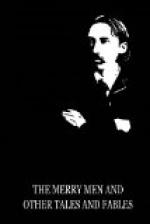|
This section contains 1,139 words (approx. 4 pages at 300 words per page) |

|
SOURCE: Ziolkowski, Theodore. “Image as Symbol: The Magic Mirror.” In Disenchanted Images: A Literary Iconography, pp. 187–90. Princeton: Princeton University Press, 1977.
In the following excerpt, Ziolkowski considers mirrors in “Markheim” as symbols of the character's confrontation with his own conscience.
We see how well the lesson of narrative stance was learned when we move ahead to two remarkable works that appeared in 1877: Robert Louis Stevenson's “Markheim” is recounted in a dispassionate third-person that identifies itself with the consciousness of the hero; Maupassant's “The Horla” narrates itself in the form of a journal. In both cases, therefore, the mirror seems to be truly magical because the appearance of the double in the mirror is narrated from the point of view of the hero, who accepts it as such.
“Markheim” is the story of a man who visits an antique dealer on Christmas Day under the pretext of buying a gift...
|
This section contains 1,139 words (approx. 4 pages at 300 words per page) |

|


